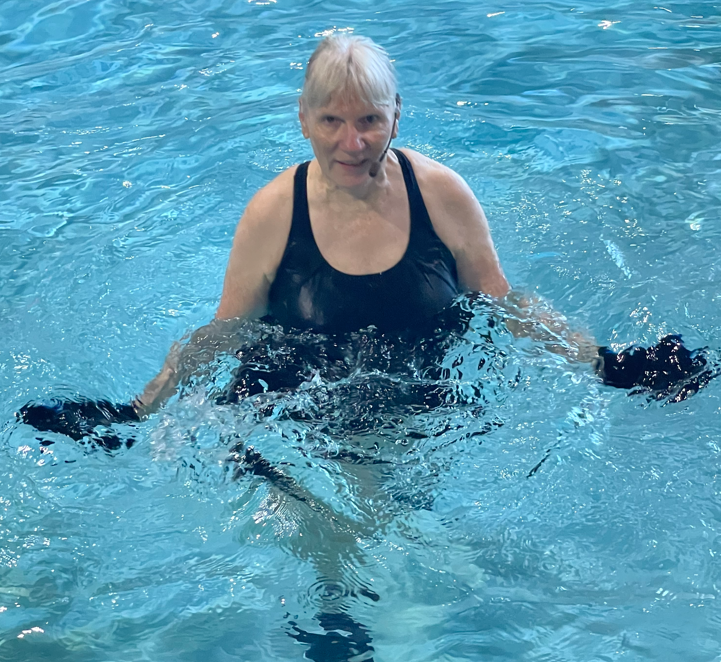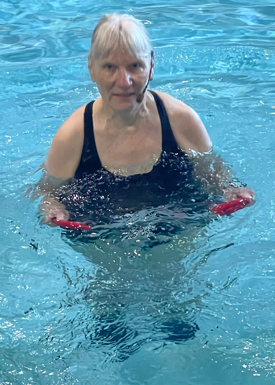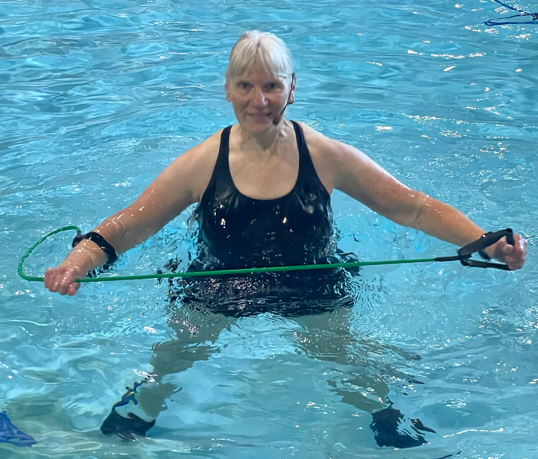When people think of water fitness, they most often think of a cardio workout. While that is emphatically true, it is also possible to strength train in the pool. You don’t even need equipment. You can use the water’s resistance and the same principles for increasing intensity that you use for aerobic exercise. Once you have mastered that, adding equipment increases the resistance. Since most of the popular equipment made for use in the pool is hand-held, the targeted muscles are in the upper body:
- Chest (Pectoralis major) – Chest fly/clap hands
- Upper back (Trapezius) – Row
- Side back (Latissimus dorsi) – Lat pull-down
- Shoulders (Front and rear deltoids) – Arm swing
- Shoulders and mid back (Rear deltoids and rhomboids) – Rear delt fly
- Shoulders (Middle deltoids) – Arm lift to the sides
- Rotator cuff – Shoulder medial rotation/rotator cuff sweep
- Biceps – Arm curl
- Triceps – Elbow extension
Increase the Range of Motion. Start by selecting your targeted muscle group, and moving your arms through their full, pain-free, range of motion. Notice how the water moves as your arms move.
Add Speed. Next increase your speed while continuing to move through your full range of motion. Your movement becomes harder. It’s easy to start slowing down, so pay attention to what you are doing.
Add Acceleration. Finally push harder against the water’s resistance. The harder you push against the water, the harder the water pushes back. You may notice that even though you are pushing harder, your movements are slowing down. When you get used to using acceleration, it is time to add equipment.
Buoyant Equipment. Nearly every pool facility has foam dumbbells in their equipment closet. Foam dumbbells were the first type of equipment specifically created for use in the pool. Buoyant equipment floats, therefore, the resistance comes from pushing the dumbbells down toward the pool floor. They are great for targeting the latissimus dorsi (as in the photo above) and the triceps. From a lunge position, if you lean forward 45 degrees with your spine in alignment, you can target the pectorals by pushing a chest fly toward the pool floor. Movements parallel to the floor, such as a row, an arm swing, a rear delt fly, and a rotator cuff sweep, create drag resistance, but the shoulder stabilizers must contract to hold the equipment under water. It is best to limit the number of reps for these exercises or avoid them if you cannot maintain good shoulder alignment. Movements toward the surface of the water, such as an arm lift to the sides or an arm curl, are assisted by buoyancy.
Drag Equipment. A variety of drag equipment is available. These increase the resistance of the water by increasing the surface area. Paddles have holes that allow water to flow through. Drag bells have multiple surface areas that create turbulence.
Drag equipment is not buoyant, and the resistance is in all directions – toward the pool floor, parallel to the pool floor, toward the surface of the water, and at any other angle. Drag equipment can be used to target any of the upper body muscle groups. Examples include a chest fly with paddles, a row with a kickboard, an arm swing with drag bells, a rotator cuff sweep with webbed gloves, and an arm curl with an Aqua Ohm, as in the photos above.
Rubberized Equipment. Resistance tubing and bands that are chlorine resistant have come on the market in the past several years. They work the same as rubberized equipment on land. There has to be an anchor point and the resistance is in pulling away from the anchor point. You can use a pool ladder as an anchor point, but that is impractical in a group exercise setting. The anchor point is usually one of your hands, or you can place the band behind your back, or from a seated position put it under your thighs, and then pull with both arms. Resistance tubing is too long to be able to hold a handle in each hand for most people. Try using one handle as the anchor point, then putting the other hand on the appropriate length of tubing. You can slip your wrist through the loose handle to keep it from flopping around in the water, as in the photo to the left of a rear delt fly.
Once you are comfortable with the equipment you can continue to increase the intensity by increasing the range of motion, adding speed, or adding acceleration, that is, by pushing or pulling harder. You can move up to a larger size foam dumbbell or drag bell, or a thicker resistance tube. You can hold a shorter length of rubberized equipment. You can close the holes on the paddles. You can use different pieces of equipment at different times to prevent your muscles from getting used to one type. Click on the name of each piece of equipment for a link to 10-second video of an exercise using that equipment. For strength training lesson plans both without and with equipment, see Water Fitness Progressions.
Let the pool be your all-purpose gym for both aerobic exercise and strength training. See you there!








